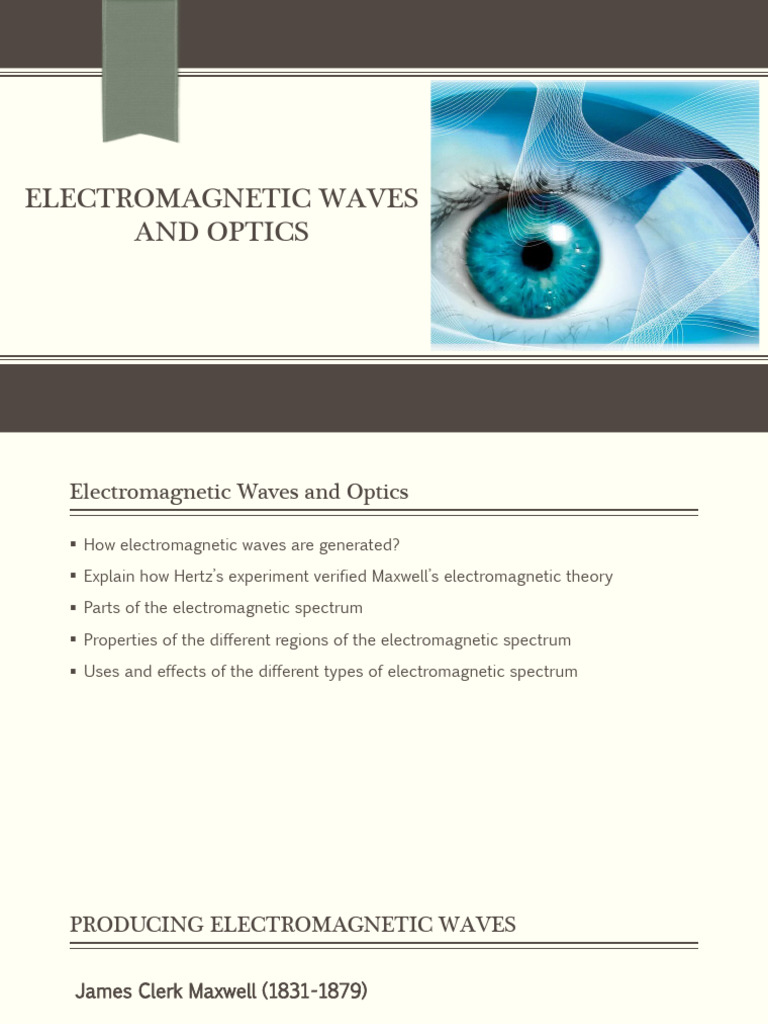In the vast realm of physics, the intricate dance between electromagnetic waves and optics serves as a cornerstone of our understanding of light and its myriad phenomena. The question of whether it is essential to study electromagnetic waves prior to delving into optics evokes intrigue. A thorough analysis reveals that a foundational understanding of electromagnetic waves can significantly enhance one’s comprehension of optical phenomena and their underlying principles.
The study of electromagnetic waves encompasses both the physical theory and mathematical frameworks that describe how these waves propagate through space. In contrast, optics specifically concerns the behavior of light as it interacts with matter, an exploration that often presupposes a foundation in the properties of electromagnetic radiation. Thus, understanding the relationship between these two fields is paramount for anyone embarking on an academic journey in physics.
To appreciate this connection, one must first consider the fundamental nature of light. Light is an electromagnetic wave characterized by oscillating electric and magnetic fields, propagating through a vacuum at a speed of approximately (3 times 10^8) meters per second. By studying electromagnetic waves, one becomes familiar with key concepts such as wavelength, frequency, and amplitude—parameters that play crucial roles in defining the behavior of visible light, as well as other forms of electromagnetic radiation.
This leads us to the concept of dispersion, a phenomenon inherent in optical studies. Dispersion occurs when different wavelengths of light travel at varying speeds through a medium, thereby causing them to refract at different angles. An understanding of electromagnetic waves sheds light on this intricate relationship between wavelength and refractive index, essential for comprehending how prisms and lenses manipulate light. Without this grounding, a student may struggle to grasp why certain materials exhibit specific colors or why rainbows form after a rainstorm.
Moreover, the wave-particle duality of light serves as a fundamental principle in both electromagnetic theory and optics. The historical development of this concept reveals a fascinating evolution of thought. Insights gained from studying electromagnetic waves facilitate a deeper appreciation for the dual nature of light. The duality manifests in phenomena such as the photoelectric effect and diffraction patterns, which are pivotal in understanding how light behaves in various contexts. Such knowledge engenders a more nuanced perspective, allowing students to appreciate the broader implications of wave-particle duality beyond mere optics.
In unlocking the mysteries of interference, another quintessential optical phenomenon, one again finds the necessity of a comprehensive background in electromagnetic theory. Interference occurs when two or more light waves superpose, resulting in regions of constructive and destructive interference. Grasping the principles of phase difference and coherent light sources—knowledge obtained through the study of electromagnetic waves—enables an individual to delve into the complexities of interference patterns observed in experiments such as Young’s double-slit experiment. The mathematics of wave functions elucidates the requisite conditions for interference, revealing a profoundly interconnected relationship between wave behavior and optical phenomena.
Furthermore, the realm of polarization introduces additional dimensions of understanding. Electromagnetic waves can oscillate in various orientations, leading to distinct polarization states. The concept of polarization is not merely an optical curiosity but a pivotal aspect that influences the design of numerous optical devices, including cameras and displays. A study of electromagnetic waves elucidates the mechanisms behind natural and artificial polarization, empowering students to appreciate the practical applications of these principles in everyday technology.
By investigating electromagnetic waves, one also gains insights into the concept of electromagnetic spectra. The spectrum spans a continuum, encompassing not only visible light but also ultraviolet, infrared, radio, and X-ray radiation. Knowledge of this expansive spectrum fosters awareness of the broader implications of light beyond the visible realm. In optics, this understanding becomes crucial when considering phenomena such as fluorescence, where materials emit light upon exposure to electromagnetic radiation outside of the visible spectrum. This interconnectedness beckons a broader inquiry into the relationship between energy levels in atoms and the resultant spectral emissions.
Ultimately, the exploration of electromagnetic waves lays the groundwork for understanding the myriad applications of optics in various scientific disciplines. From the design of advanced imaging systems in medicine to the development of innovative optical materials in telecommunications, a solid grounding in electromagnetic theory is indispensable for aspiring physicists and engineers alike. The interplay between theory and application, illuminated through the lens of electromagnetic studies, extends into realms such as quantum optics, where the principles of both fields converge in fascinating ways.
In conclusion, the interplay between electromagnetic waves and optics reveals not merely a sequential learning paradigm but a rich tapestry of interconnected principles that amplify comprehension and application. To navigate the intricacies of optics with clarity and depth, a preamble in electromagnetic waves is not just beneficial—it is essential. By embracing this foundational knowledge, students and scholars alike can endeavor into the captivating universe of light and its endless manifestations, fostering curiosity and igniting passion for discovery within the field of physics.










